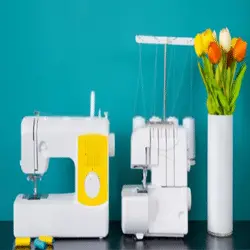What is a serger? What is serging? How does it work? What is the difference b/w serger & sewing machine? Visit the page to know all about it.
Sergers and sewing machines are often confused for the same thing. One can’t replace the other, but instead, they complement each other well!

Serging functions to finish off unfinished seams while a regular machine would work best on finished fabric with no loose threads or raw edges.
- Serger vs Sewing Machine
- What Is Serging & How It Works?
- What Is Sergering Used For?
- Should You Buy A Serger OR A Sewing Machine?
- When Should You Use a Serger?
Serger vs. Sewing Machine – What is The Difference?
What Is a Serger?
Sergers are professional-grade sewing machines that create a binding for fabric using three or more thread sources. They’re not the same as your average machine, but they do come with an overlock stitch to make this process easier.
What Is a Sewing Machine?
A sewing machine is a lockstitch and it can cover many basic stitches like a straight, chain, or zigzag. While some may have the ability to create more decorative designs such as French seams with their fancy options on offer!
Similar Features Of The Two
The interesting fact about a serger is that it can perform lots of functions that a sewing machine can. The common functions of both are:
- It can gather fabric
- It can do a narrow rolled hem
- It can neatly do piping
- It can even hem knits
Differences Of The Two
There are many differences between a serger and a sewing machine, but they both rely on an overlock stitch. A serging machine uses this type of binding for the upper thread to create more emphasis in areas such as hems while sewing machines use lockstitches or chain stitches instead.
Sergers use three or more thread sources.
There isn’t a lot of variety in stitches for serger machines; you’re just getting an overlock stitch, which means they don’t have many options like how sewing machines can be set up with different types and styles to create various looks on your garment or project’s seams as well as being able to sew at varying speeds depending upon the type that would best suit what needs doing (e.g., commercial vs home).
What Is Serging?
Serging is a technique used to prevent fabrics from unraveling. You might recognize this process, called overlocking or stitch-and-sew in sewing terms but can refer interchangeably depending on where you live!
To avoid unraveling fabric, serging, or overlocking it will give your material a professional finish. Usually, this process is done with the help of either a sewing machine and/or a serger (a type of machine that makes edges fray-free).
If you don’t have access to one of these tools then make sure there’s no naked thread when completing zigzag stitches on both sides as they can cause undo harm!
What Is Sergering Used For?
Sergers are the best tool for professionals who work with fabric. They can do so much more than just hemming and finishing your garment; serging is also perfect for creating seam allowances, trimming excess thread off finished edges, or taking up slack in seams before stitching them down.
The machine does this all at once which makes using one easier because you don’t have to worry about operating multiple machines!
What is Serging Used for? Well serging is used for many purposes, such as:
Sewing Seams
Sergers are great for sewing seams because they allow you to sew, cut off excess material, and overcast the raw edge at once. Serged seams won’t unravel like other types of stitching can when stretch is involved!
It’s also useful if your serger has four threads per stitch– it means this type of seam will work with any kind or amount of fabric that needs to be sewn securely yet still be able to stretch without giving way under pressure from movement (like wearing).
Overcasting Edges
Using the 3-thread overcast stitch to trim your fabric edges is a great way of ensuring that they are all neat and even. This technique works best when sewing with one layer on top, but two layers can also benefit from it if done carefully!
Making Flatlock Seams
What is flatlock? Flatlock seams are decorative, reversible, and have no seam allowance. They’re great for adding color to your craft as you can use different colors of thread on each side when joining two fabrics together!
Creating Perfectly-Rolled Hems
Sergers are a great way to create uniform tiny, rolled hems. Some outfits like wedding veils and napkins would require these types of seams so using one is easy with this nifty machine!
Easily Handles Stretchy Fabric
The speed of a serger is adjustable to accommodate different types of fabric. By changing the ratio between front and back feed dogs, you can make sure your seams stay tight when sewing with stretchy or puckering materials!
Gathering
Sergers are used to gather fabric, sewing machines can do it too. All you need is 2 lines of straight stitches and pull hard on either side for good measure!
Should You Buy A Serger OR A Sewing Machine?
If you’re a beginner who does not already have a sewing machine, then get one first. Sergers are efficient but cannot perform basic tasks like the regular machines can; however they can be used to add professionalism and style if utilized correctly with your own creativity!
When Should You Use a Serger?
Sergers are great for all-around use, but they come into their own when working with garments that need to be hemmed or contain fabric pieces sewn together at an angle.
Serger seams will not fray as much and the stitching withstands more wear because you can eliminate some tedious steps before getting down on your sewing machine!
Related Article: How To Use A Serger

Robert Patricia
Robert Patricia is a data analytic and content creator. He has worked extensively with large data sets to glean insights for both public and private sector clients. He has used this knowledge to create compelling content for brands across the internet. Albert also enjoys creating content for websites and social media. He is an expert at creating catchy headlines and understands how to capture the attention of readers.
